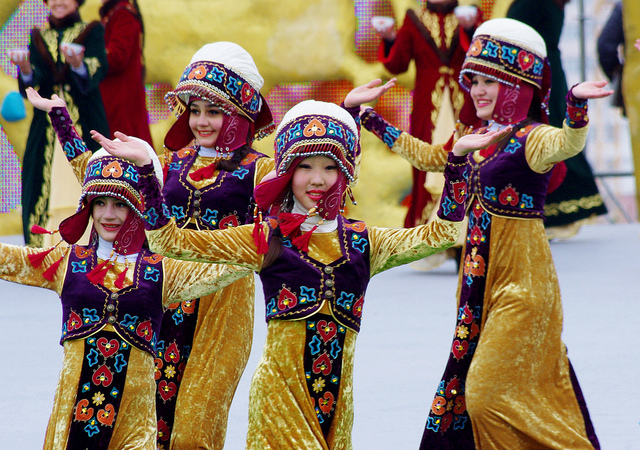There are several doors to the heart of a nation’s culture and history. Next to food and language the most important ones are with certainty its music and the according dances. Traditional dances are a reflection of people’s daily life and a nation’s character. On the fun side, they also offer a great possibility to interact with locals during your rally adventure and to have a blast with them on the dance-floor. With our little guide about the traditional dances of Central Asia, you’ll be able to practice the right moves way ahead of time!
Photo by Ken and Nyetta
Kazakhstan
Kazakhstan’s ancient dance culture doesn’t allow any celebrations to happen without dances and dance competitions of all kind. But in recent years Kara Jorga, which has almost been forgotten for decades, has remerged as the Kazakhs’ most famous dance song, whose lyrics tell about the importance and the beauty of dancing. It is basically an invitation for everyone to join the dance and have a good time together. The song is so important for the Kazaks that it was even nominated to be listed as Intangible Cultural Heritage of Humanity.
The dance itself consists of various nuances and techniques and shows a broad spectrum of emotions form pugnacity to simple fooling around. It used to be performed by young horsemen, showing off their abilities, so there is often some kind of competition and dance-off involved.
If the video above is a little too advanced for your dancing skills, then try this step by step tutorial and off you go for an epic party with some Kazakhs.
Uzbekistan
Uzbek dances stand out with their complicated hand gestures in combination with vivid facial expressions. Uzbekistan differentiates between three schools of classic dance, which are regarded as high art and are characterized by different movements, and traditional folk dances with a huge regional variety.
One of these genres of folk dances, which has risen to considerable popularity all over Uzbekistan, is the Lazgi, originating in a region near the Aral Sea. The movements are reflecting chores of people’s everyday life, like picking fruit or spinning.
Fear not, not all lazgi dancers are as beautiful as Hulka Abduleva above. In truth, most of them look rather like the guys below, so no need for restraining your inner dance champion!
Tajikistan
Also in Tajikistan dancing is strongly connected with every important event. The dances are as various as they are ancient: from the aggressive and warlike shamsherbozi, performed with swords by men to the oldest form, pantomime dances imitating animals you can pick your favorite. Also dances with various objects like axes, jugs or even spoons are popular. Most of them contain some dramatic aspects, some of them also contain some comical ones. Different regions have different dances, different costumes and also the music varies.
Women wear their beautifully embroidered, traditional dresses and put all their grace, elegance and coyness in the difficile dance moves rich of details.
The Tajik Eagle dance gives a special insight in the people’s ancient culture. The dancer mimics with great skill the movements of an eagle and leaves the audience with the impression to have watched an eagle gliding majestically across the sky.
Kyrgyzstan
Like in its neighbour Kazakhstan, the Kara Jorgo is the dance of choice of the Kyrgyzs people. After the fall of the UDSSR especially young people are rediscovering their roots and national identity, Kara Jorgo being an important part of the process. While the movements are a bit slower than in Kazkhstan, there is just no party going on in Kyrgyzstan without the characteristic shoulder and arm moves, resembling a hunter looking for prey.
But also more difficile forms of traditional Kyrgyz dances are well alive, how these beautiful ladies are showing us.





Leave a Reply